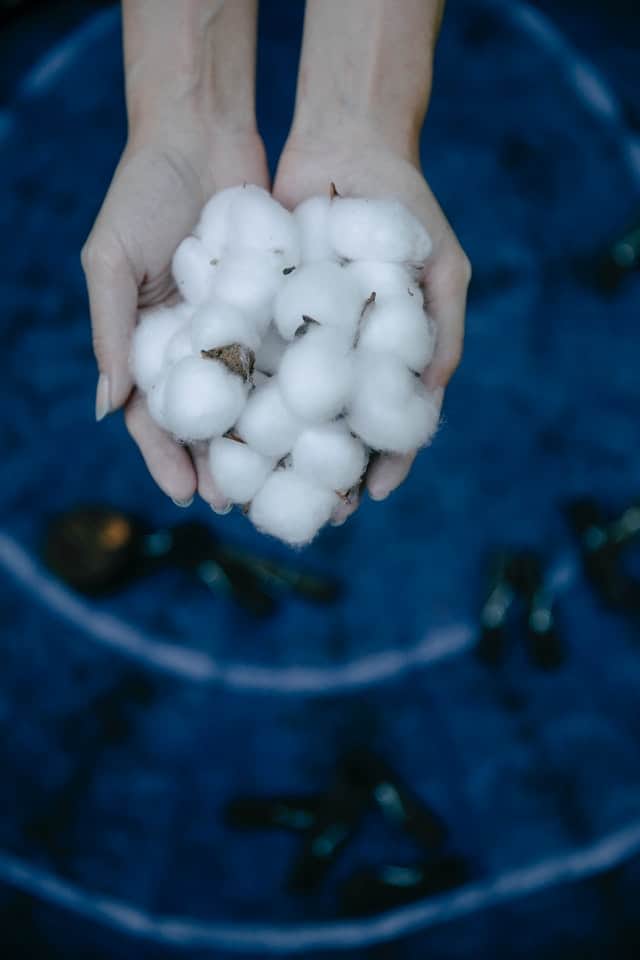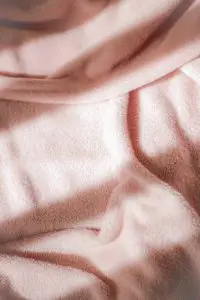Linen and cotton are durable, soft, and breathable fabrics from natural fabrics. Therefore, you’re probably wondering how they differ. In examining linen vs cotton, it’s clear that each material thrives on various elements. This includes absorbency and breathability. In addition, both cotton and linen are eco-friendly, but crucial differences between the two fabrics make them unique.
This article explores the differences between linen and cotton. We also cover the crucial information you need to know to properly utilize these fabrics to their full potential. First, however, you’ll notice that there are significant similarities between these fabrics.
What is Cotton?
Cotton is a staple fiber gotten from the cotton plant. This makes it part of the Malvaceae family. As a staple fiber, it is composed of different lengths for the material. The part of the cotton plant that becomes the cotton fabric is the part growing in the boll. It usually encases the fluffy cotton fiber. Therefore, cotton is a soft and fluffy material spun and woven to create a durable and strong fabric.
What is Linen?
Linen is a solid and lightweight fabric derived from the flax plant. It is a part of the Linaceae family, and the word comes from the Latin name for flax, ’linim usitatissimum.’ Like cotton fiber, linen is a natural fiber. However, it takes much longer to harvest and make into the fabric. This is because flax fiber is quite difficult to weave. Therefore, fibers are extracted from the plant and stored for an extended period to soften them. It is commonly used in the production of napkins, bed sheets, towels, and even tablecloths. Linen is a term that still refers to these household items, although not all of them come from the linen fabric.
Linen vs Cotton: How You Can Use Both Textiles
Although this linen vs cotton comparison focuses on the differences between these fabrics, they’re commonly used for everyday products. Below are some common uses of cotton and linen.
Beddings
If you want a good night’s sleep, you should opt for linen bedding. This is because linen has temperature-regulating qualities that will keep you cool on warm nights and warm on cool nights. Additionally, it takes away any moisture from the body and wicks this moisture away.
Cotton is also famous for bedding and is better than synthetic fibers. Because cotton fibers have pleasing aesthetic qualities, manufacturers usually weave these fabrics into higher thread counts. This feature adds to the comfort of cotton. However, if you’re looking for top-quality bedding fabric, linen is a better option for you.
Table Linens
The key to a beautiful table setting is using quality linen on every occasion. This fabric can prevent stains, spills, and frequent washings. You must utilize quality fabrics that won’t fall apart to handle this. It’s ideal to use soft fabrics like cotton and linen because synthetic materials do not have the look and feel of quality.
Linen is very absorbent and long-lasting; it also improves with every wash. It also does quite well, and it usually features prints on it for the ultimate customization. Cotton is also quite popular for table linen, especially Egyptian cotton. It also has the same qualities as linen, but it doesn’t absorb spills and stains as linen does. Additionally, its look isn’t as appealing as linen after continuous washing.
Window Treatments
Fine linen might be the better option when it comes to window treatments. It has a luxurious look and feels that makes it a leading choice. In addition, linen is a billowy fabric that provides you with a tailored look. This makes linen an excellent material if you want light and airflow to filter into this space. It is also quite firm and dries much faster than cotton. Additionally, it is well absorbent for different stains and spills.
Like linen, cotton also drapes well, and you can make it into a tight weave to provide more privacy for users. Additionally, it is a great option to block more sunlight from your indoor space. Sheet cotton can also provide a light feel for the room by gently filtering light out.
Kitchen Linens
Linen is also a great option when it comes to kitchen linen. The linen is quite absorbent and dries effectively. As kitchen linen, it allows you to use a kitchen towel many times without washing your hand in between. In addition, there is no musty smell due to the linen’s antimicrobial features. This feature will also come in handy when drying and hand-washing dishes. Linens are durable and top-quality. Therefore, it will provide you with more uses.
Cotton towels are just as absorbent, and they tend to hold water longer than linen does. However, this also means that it takes a while for cotton kitchen towels to air dry. In addition, cotton is not as durable as linen. Therefore, you may end up replacing your cotton quite often than linen.
Linen vs Cotton – Key Differences
There are salient differences between linen and cotton that you should note. This section explores how these two fabrics differ from the other.
Linen vs Cotton – Sustainability
Most would argue that linen is a more sustainable fabric than cotton. This is because flax plants require less water to survive, unlike cotton. Additionally, it requires less water to turn a flax plant into a fiber, unlike cotton. Since flax is a hardy plant, there’s no need for as much pesticide to remain healthy as it grows. On the other hand, cotton requires lots of pesticides because it has the boll weevil to contend with as it grows. This weevil eats cotton at all times. Therefore, pesticides are crucial to keep the plant healthy in order to produce a vast amount of cotton.
Additionally, it is worthy of note in this linen vs cotton comparison that linen is a more eco-friendly option. There’s less need for chemicals to turn flax fibers into linen. On the other hand, cotton is a needy plant that requires many chemicals. You also need a large acreage to grow cotton. Therefore planters need to own a vast land space.
Linen vs Cotton – Cost
Unlike cotton, you cannot grow flax everywhere there is soil. Flax is native to the fertile crescent of India. On the other hand, you can find cotton almost everywhere. This difference in habitats significantly influences the price of these fabrics. Although flax is grown on the Canadian prairies, you cannot use it to make linen fabrics. This limitation drives up the cost, making linen far pricier than cotton.
As pointed out in this linen vs cotton comparison, cotton can be grown almost anywhere. This leads to low demand for the fabric. You can also grow cotton in large quantities, helping you meet available demand and therefore keeping the cost relatively low. Although the two materials enjoy a long history as far back as 5000 years, this history doesn’t affect the price of flax or linen. There are lower qualities of the two fabrics available at a lower cost. However, linen might still be expensive even in this low-quality category.
Linen vs Cotton – Breathability
The linen vs cotton comparison isn’t complete without reviewing the fabrics’ breathability. Most people will pick linen over cotton if they reside in a high-humidity region. This is because linen works well in this environment, making cotton a second option. Although both fabrics have excellent breathability capability, linen has the edge over cotton.
At night, cotton sheets can cause you to overheat, while linen will always have you resting comfortably. In addition to its impressive breathability feature, linen dries fast. Therefore, it would be challenging to spot sweat marks on linen when you wake up. Although cotton also performs excellently, it doesn’t compare to linen, especially when the humidity increases. However, cotton has many features and is less costly. This makes it a top choice for most over linen.
Linen vs Cotton – Durability
Cotton has more stretchiness and flexibility than linen. However, it isn’t as durable as the latter. This is because flax survives in harsh conditions and requires little water and pesticide to grow. On the other hand, fine cotton-like Egyptian cotton comes from long-staple cotton fiber, making it softer and more durable than regular cotton.
The linen is more rigid and lasts longer because its cellulose fibers are longer and wrapped tighter than cotton. This feature helps to improve its strength and longevity.
Linen vs Cotton – Absorbency
In terms of absorbency, cotton shines quite bright. It is an absorbent fabric that performs much better than linen. Although linen comes quite close, it is cotton you want to turn to when there’s a big spill. This is quite important, although linen is stronger and more durable. However, it doesn’t have the edge that cotton does in similar situations. Cotton can effectively absorb 25% of its weight in moisture.
However, linen tends to surpass cotton in this linen vs cotton comparison when it comes to the option that dries faster. Linen dries quicker and is therefore ready for more spills a lot quicker. With cotton’s absorbency rate, you might not need to clean more spills.
Is Linen-Cotton Blend a Good Option?
Linen blends excellently with other fabrics, and integrating it with cotton fabric is an ideal combination. With a linen-cotton blend, you bypass the cotton issues pointed out in this linen vs cotton comparison. Additionally, you’ll get the colors, and fewer wrinkles feature that cotton offers. This is a quality you would need since linen doesn’t dye well. Therefore, there’s a limited color range to turn to. Additionally, the linen part of this blend also makes it suitable for upcoming humidity.
The durability of linen also assists the cotton material to last longer. Therefore, your clothes will keep you cool while offering breathability features. Additionally, the fast-drying qualities of linen will make sure you look your best even when the temperature begins to get hotter than average. A top-quality cotton-linen blend is always worth the investment.
A Great Online Class: Color Theory for Textile Projects by Domestika
If you are interested in learning more about how you can create a successful name for your business, we recommend taking a look at the online class “Color Theory for Textile Projects”.
The course is currently under promotion, but you can use the discount code: T_BROWNLEES-PROMO to get an additional 10% discount on your purchase.
This online class offered by Domestika, at a very inexpensive price covers all you need to know to develop your textile project by leveraging color theory to create the perfect color palette. If you apply to the course through the link below you’ll be supporting 440 Industries, and we thank you for it!
Final Thoughts
Linen and cotton ate two natural fabrics that you can use for various purposes. They have several similar characteristics, but the linen vs cotton differences set them apart. The main differences between cotton and linen are their cost and breathability. However, due to the high price of linen, more people tend to purchase cotton. However, if you’re looking for durability and breathability, your best option is linen. This linen vs cotton comparison provides you with insight to make the ideal choice on the fabric you prefer.








